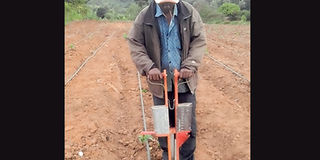Agronomist's notebook: Planting with accuracy for better yields

A farmer uses a simple planter in a farm in Makueni. To ensure maximum land utilisation, farmers should check on spacing, the purpose of the crop, soil fertility and growth habits of the crops. PHOTO | COURTESY
What you need to know:
- Using the tool, precise quantities of seeds and fertilisers are dropped by hand into the funnel, which deposits the seeds and the fertiliser into two separates holes.
- One has to be careful while using the tool to ensure uniform and correct spacing and avoid stepping on the planted areas. Proper spacing encourages adequate space utilisation.
- Different field operations require certain tractors. For instance, the mould board tractor is good when harrowing.
- Plant population is very critical in crop production. For example, determining plant population per square metre helps the farmer identify the population for the entire farm and the inputs to be used.
Every farmer desires to have tools that can enable him or her to make work easier, from planting to harvesting.
One tool that lessens work for the smallholder farmer during planting is a hand-held manual precision seed planter, which I came across during an excursion in Makueni recently.
The tool is designed for farmers practising conservation agriculture, but the others can also use it.
The gadget plants exact quantities of seeds and applies the required fertiliser at the same time.
The tool creates slots through the soil in a gradual manner by use of the metal tip, which pierces the soil and deposits the seeds.
This enhances the proper depth of the seeds and encourages uniform germination.
Using the tool, precise quantities of seeds and fertilisers are dropped by hand into the funnel, which deposits the seeds and the fertiliser into two separates holes. This prevents scorching the grains with the fertiliser.
Some of the crops one can grow using the technology are maize, cowpeas and beans.
One has to be careful while using the tool to ensure uniform and correct spacing and avoid stepping on the planted areas. Proper spacing encourages adequate space utilisation.
This simple tool that goes for between Sh7,000 and Sh12,000 depending on the size, saves labour, especially where one has to make planting holes, apply fertiliser, sow seeds, and finally cover them.
Using the tool, one maintains the soil structure and the chances of erosion are minimised. The method of planting minimises soil disturbance and maintains an organic surface layer, a challenge to many farmers.
GOOD MANAGEMENT PRACTICES
As small-scale farmers embrace the hand-held planter, large-scale growers should use tractor-driven planters to save time during planting.
Different field operations require certain tractors. For instance, the mould board tractor is good when harrowing.
This tractor can break hard pan, achieve uniform depth, and break soil clods. Disc plough should usually be used in rocky areas.
To ensure maximum land utilisation, farmers should check on spacing, the purpose of the crop, soil fertility and growth habits of the crops.
Proper spacing also enhances good management practices such as weeding, pest and disease management as well as harvesting.
Plant population is very critical in crop production. For example, determining plant population per square metre helps the farmer identify the population for the entire farm and the inputs to be used.
Correct spacing also ensures maximum nutrients utilisation and prevents competition of nutrients among the plants.
Incorrect spacing that results in overcrowding of plants encourages fungal diseases in crops and pest infestation.
The farmer should, therefore, be keen when planting to ensure the ideal spacing and correct populations.
In crops such as potatoes, overcrowding results in smaller tubers lowering the production.
Depth of planting is also an essential factor to be considered since seeds are not of the same size. For example, small seeds sowed in the nursery should be planted at a depth of about 2cm.
Deep planting hinders the seeds from germinating. Maize seeds should be planted at a depth of about 5-10cm since the seeds are large.




